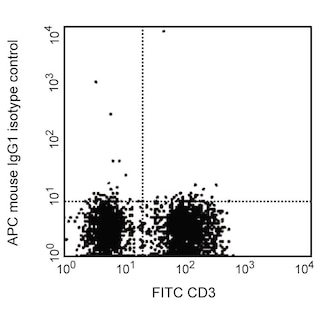Old Browser
This page has been recently translated and is available in French now.
Looks like you're visiting us from {countryName}.
Would you like to stay on the current country site or be switched to your country?


.png)

Multiparameter flow cytometric analysis of CD15 expression on human peripheral blood leucocyte populations. Human whole blood was stained with either APC Mouse IgG1, κ Isotype Control (Cat No. 554681; Left Plot) or APC Mouse Anti-Human CD15 antibody (Cat No. 567958/567959; Right Plot). The erythrocytes were lysed with BD FACS™ Lysing Solution (Cat. No. 349202). A bivariate pseudocolor density plot showing the correlated expression of CD15 (or Ig Isotype control staining) versus side light-scatter signals (SSC) was derived from gated events with the forward and side light-scatter characteristics of intact human leucocytes. Flow cytometry and data analysis were performed using a BD LSRFortessa™ Cell Analyzer System and FlowJo™ software.
.png)

BD Pharmingen™ APC Mouse Anti-Human CD15
.png)
Regulatory Status Legend
Any use of products other than the permitted use without the express written authorization of Becton, Dickinson and Company is strictly prohibited.
Preparation And Storage
Recommended Assay Procedures
BD® CompBeads can be used as surrogates to assess fluorescence spillover (Compensation). When fluorochrome conjugated antibodies are bound to BD® CompBeads, they have spectral properties very similar to cells. However, for some fluorochromes there can be small differences in spectral emissions compared to cells, resulting in spillover values that differ when compared to biological controls. It is strongly recommended that when using a reagent for the first time, users compare the spillover on cells and BD® CompBeads to ensure that BD® CompBeads are appropriate for your specific cellular application.
Product Notices
- Please refer to www.bdbiosciences.com/us/s/resources for technical protocols.
- Source of all serum proteins is from USDA inspected abattoirs located in the United States.
- Caution: Sodium azide yields highly toxic hydrazoic acid under acidic conditions. Dilute azide compounds in running water before discarding to avoid accumulation of potentially explosive deposits in plumbing.
- This reagent has been pre-diluted for use at the recommended Volume per Test. We typically use 1 × 10^6 cells in a 100-µl experimental sample (a test).
- This APC-conjugated reagent can be used in any flow cytometer equipped with a dye, HeNe, or red diode laser.
- For fluorochrome spectra and suitable instrument settings, please refer to our Multicolor Flow Cytometry web page at www.bdbiosciences.com/colors.
- An isotype control should be used at the same concentration as the antibody of interest.
- Please refer to http://regdocs.bd.com to access safety data sheets (SDS).
Companion Products



The 7C3.rMAb is a recombinant monoclonal antibody that specifically recognizes human CD15 which is a terminal carbohydrate epitope, 3-fucosyl-N-acetyllactosamine (3-FAL), on cell surface glycoproteins or glycolipids. CD15 is also known as Lewis X (LeX), X-Hapten, or Stage-Specific Embryonic Antigen-1 (SSEA-1). The 7C3.rMAb was derived from the 7C3 (also known as, PMN7C3) hybridoma. The 7C3 antibody was validated at HLDA V (Workshop Number MA88). The 7C3.rMAb has the same IgV-region heavy chain domain and Ig, κ light chain as the original mouse 7C3 IgG3, κ antibody. The remaining Ig constant heavy chain of 7C3.rMAb is derived from the mouse IgG1 heavy chain. CD15 is expressed on a variety of cell types including neutrophils, eosinophils, monocytes, macrophages, mast cells, and Langerhans cells. CD15 is also expressed on some epithelial cells, activated lymphocytes as well as tumor cells. CD15 is not expressed by platelets or erythrocytes. CD15 plays various roles in mediating cellular adhesion, activation, migration, and phagocytosis.

Development References (7)
-
Ball ED, Persichetti J, Roscoe R, Nimgaonkar M, Winkelstein A. Expression of CD15 on CD34+ cells of the bone marrow, peripheral blood, and umbilical cord blood. In: Schlossman SF. Stuart F. Schlossman .. et al., ed. Leucocyte typing V : white cell differentiation antigens : proceedings of the fifth international workshop and conference held in Boston, USA, 3-7 November, 1993. Oxford: Oxford University Press; 1995:795-798.
-
Ball ED. CD15 cluster workshop report. In: Schlossman SF. Stuart F. Schlossman .. et al., ed. Leucocyte typing V : white cell differentiation antigens : proceedings of the fifth international workshop and conference held in Boston, USA, 3-7 November, 1993. Oxford: Oxford University Press; 1995:790-794.
-
Larsen GR, Sako D, Ahern TJ, et al. P-selectin and E-selectin. Distinct but overlapping leukocyte ligand specificities.. J Biol Chem. 1992; 267(16):11104-10. (Clone-specific: Cell separation). View Reference
-
Masat T, Feliu E, Villamor N, et al. Immunophenotypic and ultrastructural study in peripheral blood neutrophil granulocytes following bone marrow transplantation.. Br J Haematol. 1997; 98(2):299-307. (Clone-specific: Flow cytometry). View Reference
-
Nauseef WM, Root RK, Newman SL, Malech HL. Inhibition of zymosan activation of human neutrophil oxidative metabolism by a mouse monoclonal antibody.. Blood. 1983; 62(3):635-44. (Immunogen: Functional assay, Inhibition). View Reference
-
Phillips ML, Schwartz BR, Etzioni A, et al. Neutrophil adhesion in leukocyte adhesion deficiency syndrome type 2.. J Clin Invest. 1995; 96(6):2898-906. (Clone-specific: Flow cytometry). View Reference
-
Sedlak J, Chorvath B, Hunakova L, Bizik J, Karpatova M, Duraj J. CD15 (Lewisx) antigen: expression on non-hemopoietic cell lines and modulation on retinois-acid-induced HL-60 cells (analysedwith CD15 Panel mAb). In: Schlossman SF. Stuart F. Schlossman .. et al., ed. Leucocyte typing V : white cell differentiation antigens : proceedings of the fifth international workshop and conference held in Boston, USA, 3-7 November, 1993. Oxford: Oxford University Press; 1995:798-800.
Please refer to Support Documents for Quality Certificates
Global - Refer to manufacturer's instructions for use and related User Manuals and Technical data sheets before using this products as described
Comparisons, where applicable, are made against older BD Technology, manual methods or are general performance claims. Comparisons are not made against non-BD technologies, unless otherwise noted.
For Research Use Only. Not for use in diagnostic or therapeutic procedures.
Report a Site Issue
This form is intended to help us improve our website experience. For other support, please visit our Contact Us page.